1993 CHEVROLET LUMINA steering
[x] Cancel search: steeringPage 119 of 324

Downloaded from www.Manualslib.com manuals search engine Part 4
Here you’ll find information about
driving on different kinds
of roads
and in varying weather conditions
.
We’ve also included many other useful tips on driving
.
Your Driving and the Road
Road Signs ........................................................................\
................................... 118
Drunken Driving ........................................................................\
......................... 123
Control of a Vehicle
Braking
........................................................................\
..................................... 126
Anti-Lock Brakes ........................................................................\
..................... 127
Steering Tips ........................................................................\
............................. 132
Steering in Emergencies ........................................................................\
.......... 133
Passing ........................................................................\
..................................... 134
Driving at Night ........................................................................\
........................... 137
Driving in the Rain ........................................................................\
...................... 139
Driving in Fog, Mist and Haze ........................................................................\
... 142
City Driving ........................................................................\
.................................. 143
Freeway Driving ........................................................................\
.......................... 144
Driving a Long Distance ........................................................................\
............. 146
Hill and Mountain Roads ........................................................................\
........... 148
Parking on Hills ........................................................................\
.......................... 149
Winter Driving ........................................................................\
............................ 151
Towing a Trailer ........................................................................\
........................... 154
Defensive Driving ........................................................................\
........................ 122
I I7
Page 127 of 324

Downloaded from www.Manualslib.com manuals search engine I
“I’ll be careful” isn’t the right answer.
What if there’s an emergency, a need to
take sudden action, as when a child
darts into the street?
A person with a
higher
BAC might not be able to react
quickly enough to avoid the collision.
There’s something else about drinking
and driving that many people don’t
know. Medical research shows that
alcohol in a person’s system can make
crash injuries worse. That’s especially
true for brain, spinal cord and heart
injuries. That means that if anyone who
has been drinking-driver or
passenger-is in a crash, the chance of
being killed or permanently disabled is
higher than if that person had not been
drinking. And we’ve already seen that the
chance
of a crash itself is higher for
drinking drivers.
Control of a Vehicle
You have three systems that make your
vehicle go where you want it to go.
They are the brakes, the steering and
the accelerator.
All three systems have
to do their work at the places where the
tires meet the road.
Sometimes, as when you’re driving on
snow or ice, it’s easy to ask more of
those control systems than the tires and
road can provide. That means you can
lose control of your vehicle.
Page 133 of 324
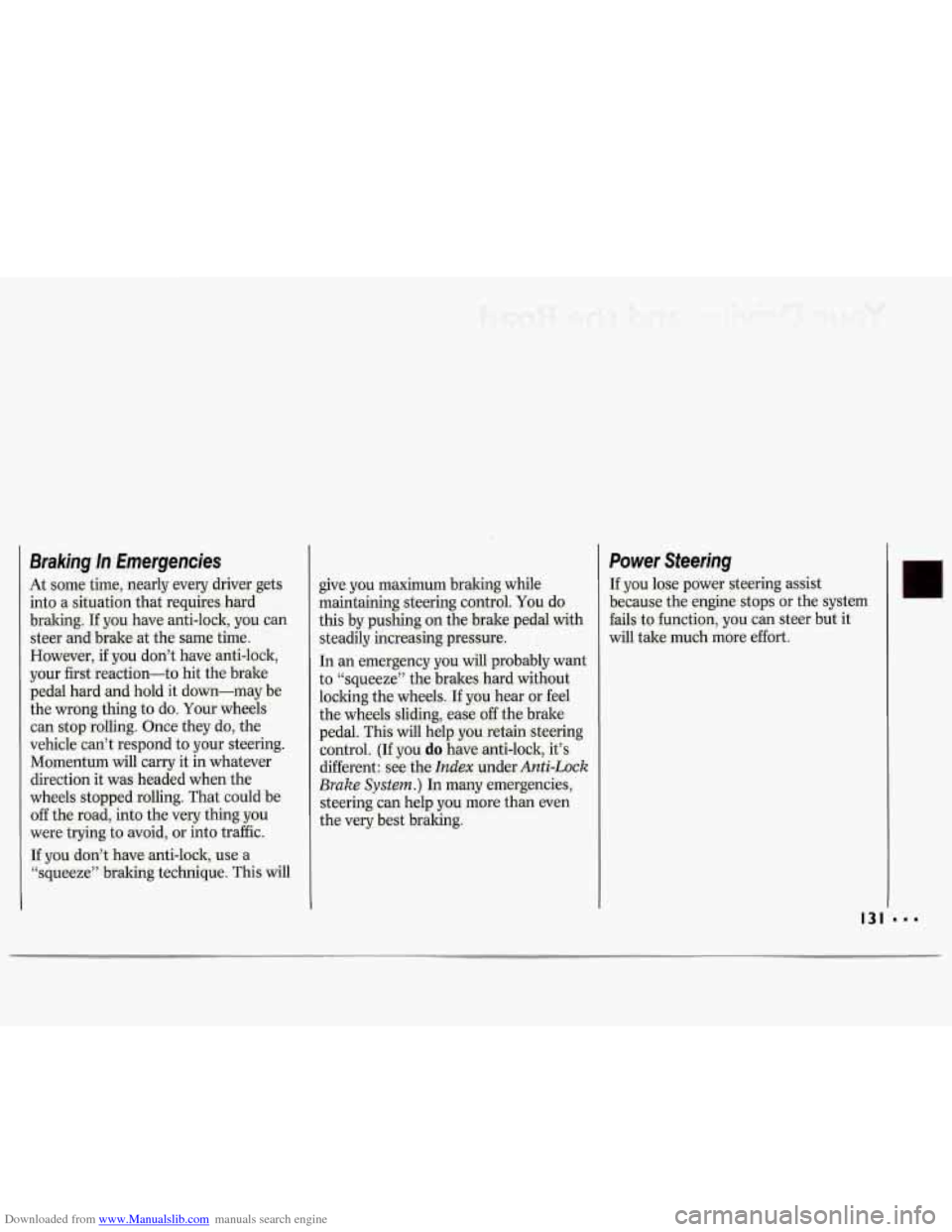
Downloaded from www.Manualslib.com manuals search engine Braking In Emergencies
At some time, nearly every driver gets into a situation that requires hard
braking.
If you have anti-lock, you can
steer and brake at the same time.
However, if you don’t have anti-lock,
your first reaction-to hit the brake
pedal hard and hold it down-may be
the wrong thing to do. Your wheels
can stop rolling. Once they
do, the
vehicle can’t respond to your steering.
Momentum will carry it in whatever
direction it was headed when the
wheels stopped rolling. That could be off the road, into the very thing you
were trying to avoid, or into traffic.
If you don’t have anti-lock, use a
“squeeze” braking technique. This will give you maximum braking while
maintaining steering control.
You do
this by pushing
on the brake pedal with
steadily increasing pressure.
In an emergency you will probably want
to “squeeze” the brakes hard without
locking the wheels. If you hear or feel
the wheels sliding, ease
off the brake
pedal. This will help you retain steering
control.
(If you do have anti-lock, it’s
different: see the
Index under Anti-Lock
Brake System.)
In many emergencies,
steering can help you more than even
the very best braking.
Power Steering
If you lose power steering assist
because the engine stops or the system
fails to function, you can steer but it
will take much more effort.
Page 134 of 324
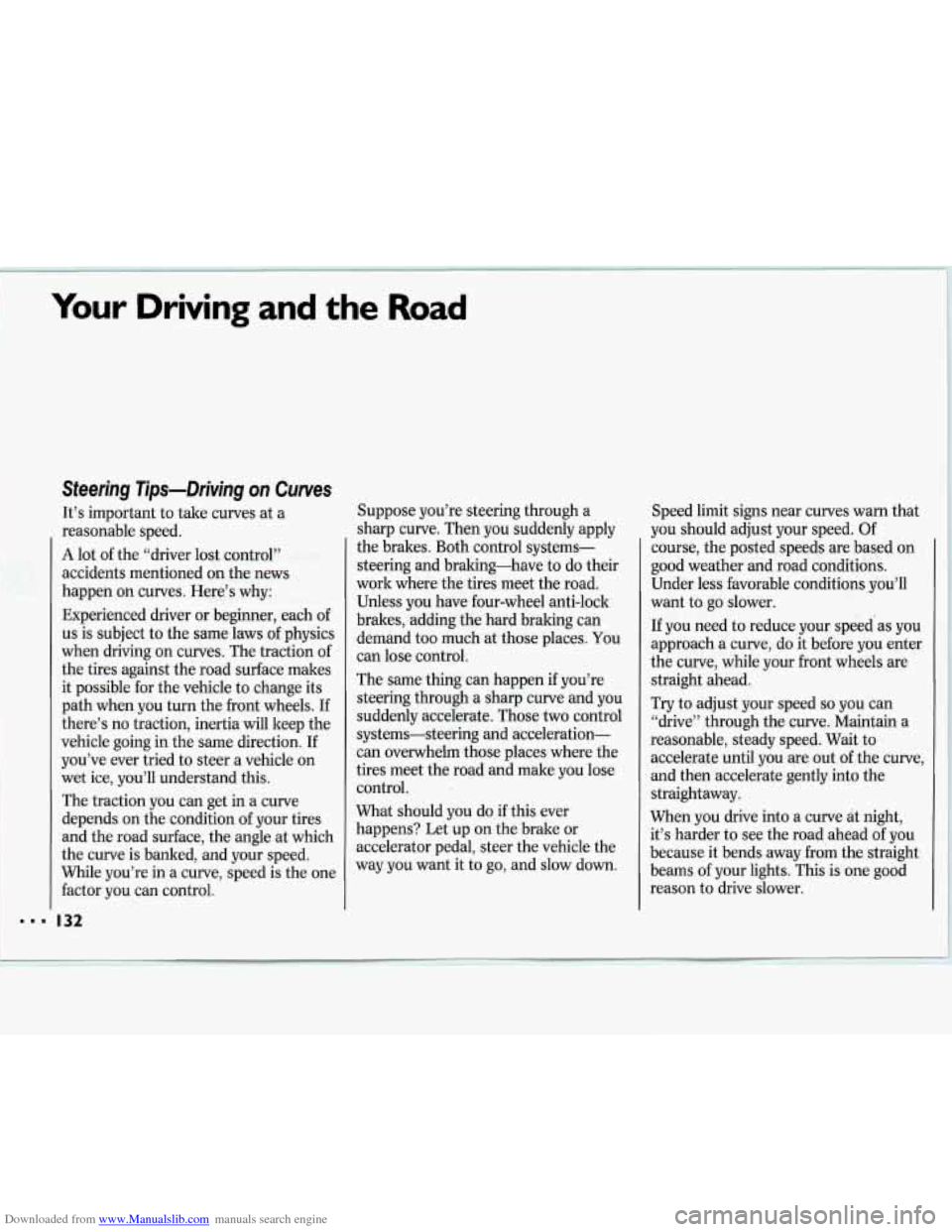
Downloaded from www.Manualslib.com manuals search engine Your Driving and the Road
Steering Tips-Driving on Curves
It’s important to take curves at a
reasonable speed.
A lot of the “driver lost control”
accidents mentioned
on the news
happen
on curves. Here’s why:
Experienced driver or beginner, each of
us is subject to the same laws of physics
when driving
on curves. The traction of
the tires against the road surface makes
it possible for the vehicle to change its
path when you turn the front wheels. If
there’s
no traction, inertia will keep the
vehicle going in the same direction. If
you’ve ever tried to steer a vehicle
on
wet ice, you’ll understand this.
The traction you can get in a curve
depends
on the condition of your tires
and the road surface, the angle at which
the curve is banked, and your speed.
While you’re in a curve, speed is the one
factor you can control. Suppose you’re steering through a
sharp curve. Then you suddenly apply
the brakes. Both control systems-
steering and braking-have to do their
work where the tires meet the road.
Unless you have four-wheel anti-lock
brakes, adding the hard braking can
demand too much at those places. You
can lose control.
The same thing can happen if you’re
steering through a sharp curve and you
suddenly accelerate. Those two control
systems-steering and acceleration-
can overwhelm those places where the
tires meet the road and make you lose
control.
What should you do if this ever
happens? Let up
on the brake or
accelerator pedal, steer the vehicle the
way you want it to go, and slow down. Speed limit signs near curves warn
that
you should adjust your speed. Of
course, the posted speeds are based
on
good weather and road conditions.
Under less favorable conditions you’ll
want to go slower.
If you need to reduce your speed’as you
approach a curve, do it before you enter
the curve, while your front wheels are
straight ahead.
Try to adjust your speed
so you can
“drive” through the curve. Maintain a
reasonable, steady speed. Wait to
accelerate until you are out of the curve,
and then accelerate gently into the
straightaway.
When you drive into a curve
at night,
it’s harder to see the road ahead of you
because it bends away from the straight
beams of your lights. This is one good
reason to drive slower.
132
Page 135 of 324
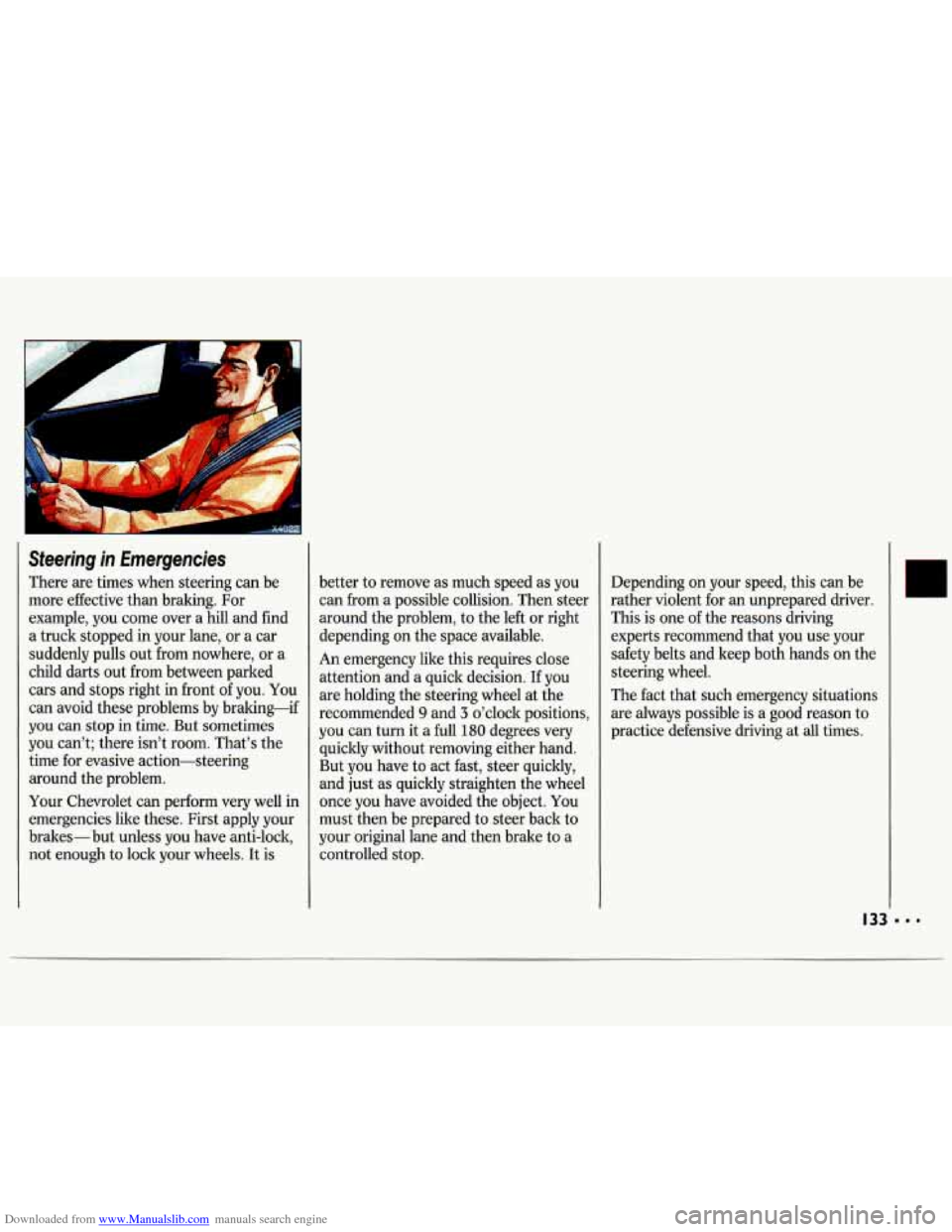
Downloaded from www.Manualslib.com manuals search engine Steering in Emergencies
There are times when steering can be
more effective than braking. For
example, you come over a hill and find
a truck stopped in your lane, or
a car
suddenly pulls out from nowhere, or a
child darts out from between parked
cars and stops right in front
of you. You
can avoid these problems by braking-if
you can stop in time. But sometimes
you can’t; there isn’t room. That’s the
time for evasive action-steering around the problem.
Your Chevrolet can perform very well in
emergencies like these. First apply your
brakes- but unless you have anti-lock,
not enough to lock your wheels. It is better
to remove as much speed as you
can from a possible collision. Then steer
around the problem, to the left or right
depending
on the space available.
An emergency like this requires close
attention and a quick decision. If you
are holding the steering wheel at the
recommended
9 and 3 o’clock positions,
you can turn it a full 180 degrees very
quickly without removing either hand.
But you have to act fast, steer quickly,
and just as quickly straighten the wheel
once you have avoided the object. You
must then be prepared to steer back
to
your original lane and then brake to a
controlled stop. Depending
on your speed, this can be
rather violent for an unprepared driver.
This is one of the reasons driving
experts recommend that you use your
safety belts and keep both hands on the
steering wheel.
The fact that such emergency situations
are always possible is a good reason to
practice defensive driving at
all times.
Page 136 of 324
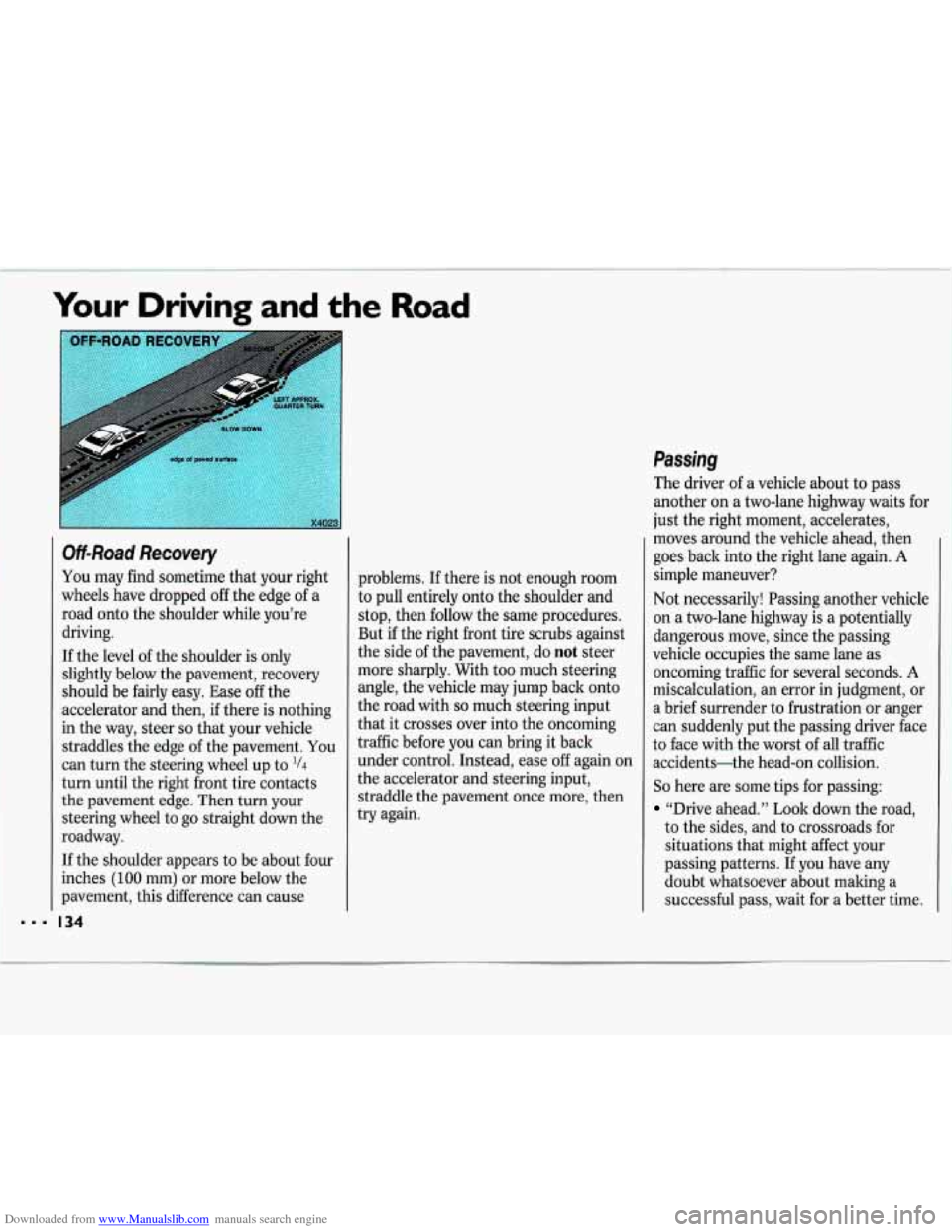
Downloaded from www.Manualslib.com manuals search engine 8.1
Your Driving and the Road
I
OH-Road Recovery
You may find sometime that your right
wheels have dropped off the edge of a
road onto the shoulder while you’re
driving.
If the level of the shoulder is only
slightly below the pavement, recovery
should be fairly easy. Ease
off the
accelerator and then, if there is nothing
in the way, steer
so that your vehicle
straddles the edge of the pavement.
You
can turn the steering wheel up to ‘/4
turn until the right front tire contacts
the pavement edge. Then turn your
steering wheel to go straight down the
roadway.
If the shoulder appears to be about four
inches
(100 mm) or more below the
pavement, this difference can cause
I34
problems. If there is not enough room
to pull entirely onto the shoulder and
stop, then follow the same procedures.
But if the right front tire scrubs against
the side of the pavement, do
not steer
more sharply. With too much steering
angle, the vehicle may jump back onto
the road with
so much steering input
that it crosses over into the oncoming
traffic before you can bring it back
under control. Instead, ease
off again on
the accelerator and steering input,
straddle the pavement once more, then
try again.
Passing
The driver of a vehicle about to pass
another on a two-lane highway waits
for
just the right moment, accelerates,
moves around the vehicle ahead, then
I
goes back into the right lane again. A
simple maneuver?
Not necessarily! Passing another vehicle
on a two-lane highway is a potentially
dangerous move, since the passing
vehicle occupies the same lane as
oncoming traffic for several seconds.
A
miscalculation, an error in judgment, or
a brief surrender to frustration or anger
can suddenly put the passing driver
face
to face with the worst of all traffic
accidents-the head-on collision.
So here are some tips for passing:
“Drive ahead.’’ Look down the road,
to the sides, and to crossroads for
situations that might affect your
passing patterns.
If you have any
doubt whatsoever about malting
a
successful pass, wait for a better time. I
Page 138 of 324
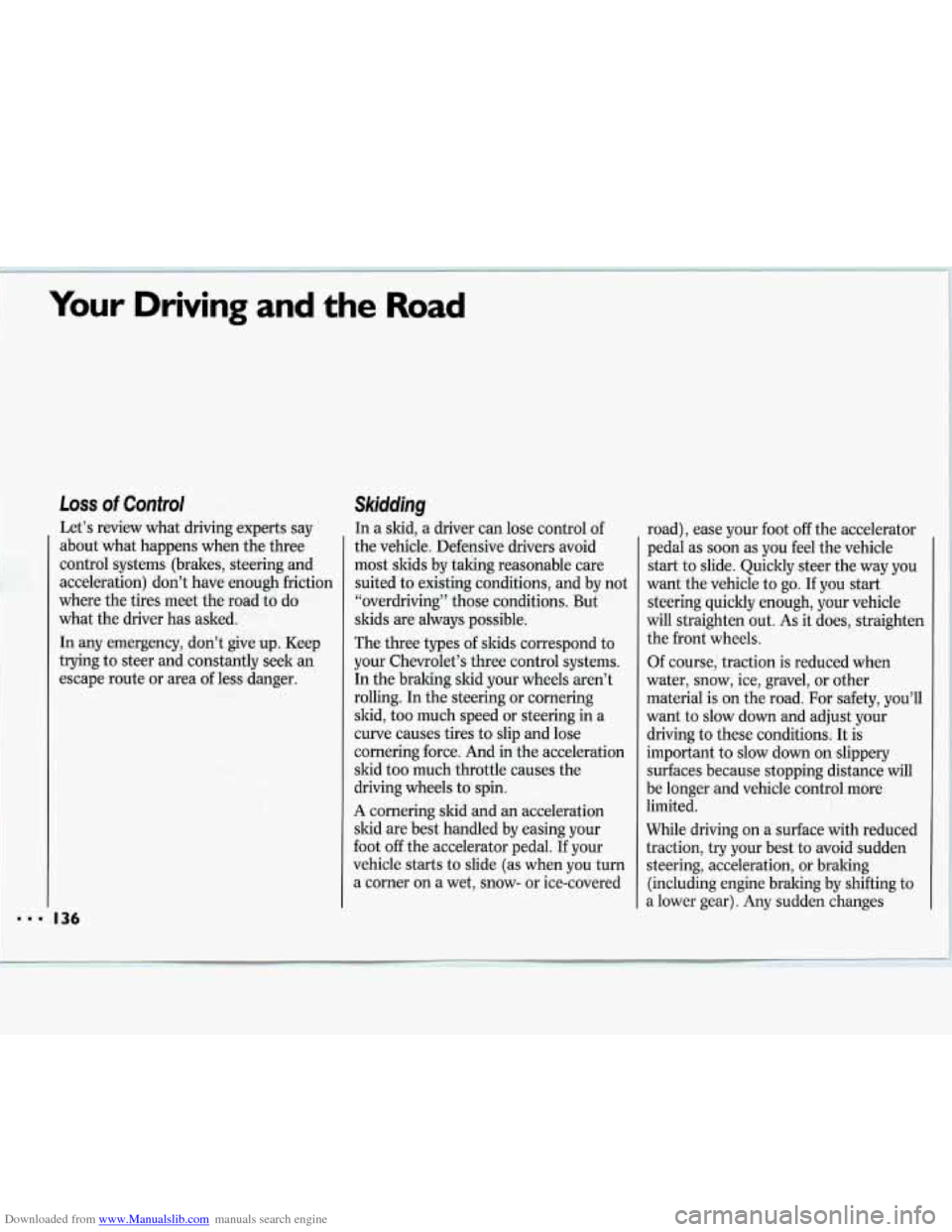
Downloaded from www.Manualslib.com manuals search engine Your Driving and the Road
Loss of Control
Let’s review what driving experts say
about what happens when the three
control systems (brakes, steering and
acceleration) don’t have enough friction
where the tires meet the road to do
what the driver has asked.
In any emergency, don’t give up. Keep
trying to steer and constantly seek an
escape route or area of less danger.
136
Skidding
In a skid, a driver can lose control of
the vehicle. Defensive drivers avoid
most skids by taking reasonable care
suited to existing conditions, and by not
“overdriving” those conditions. But
skids are always possible.
The three types
of skids correspond to
your Chevrolet’s three control systems. In the braking skid your wheels aren’t
rolling. In the steering or cornering
skid, too much speed or steering in a
curve causes tires to slip and lose
cornering force. And in the acceleration
skid too much throttle causes the
driving wheels to spin.
A cornering skid and an acceleration
skid are best handled by easing your
foot
off the accelerator pedal. If your
vehicle starts to slide (as when you turn
a corner on a wet, snow- or ice-covered road),
ease your foot
off the accelerator
pedal as soon as you feel the vehicle
start to slide. Quickly steer the way you
want the vehicle to go. If you start
steering quickly enough, your vehicle
will straighten out.
As it does, straighten
the front wheels.
Of course, traction is reduced when
I 1
water, snow, ice, gravel, or other
material is on the road. For safety, you’ll
I I
want to slow down and adjust your
driving to these conditions. It is
important to slow down
on slippery
surfaces because stopping distance will
be longer and vehicle control more
limited.
While driving
on a surface with reduced
traction, try your best to avoid sudden
steering, acceleration, or braking
(including engine braking by shifting to
a lower gear).
Any sudden changes
Page 139 of 324
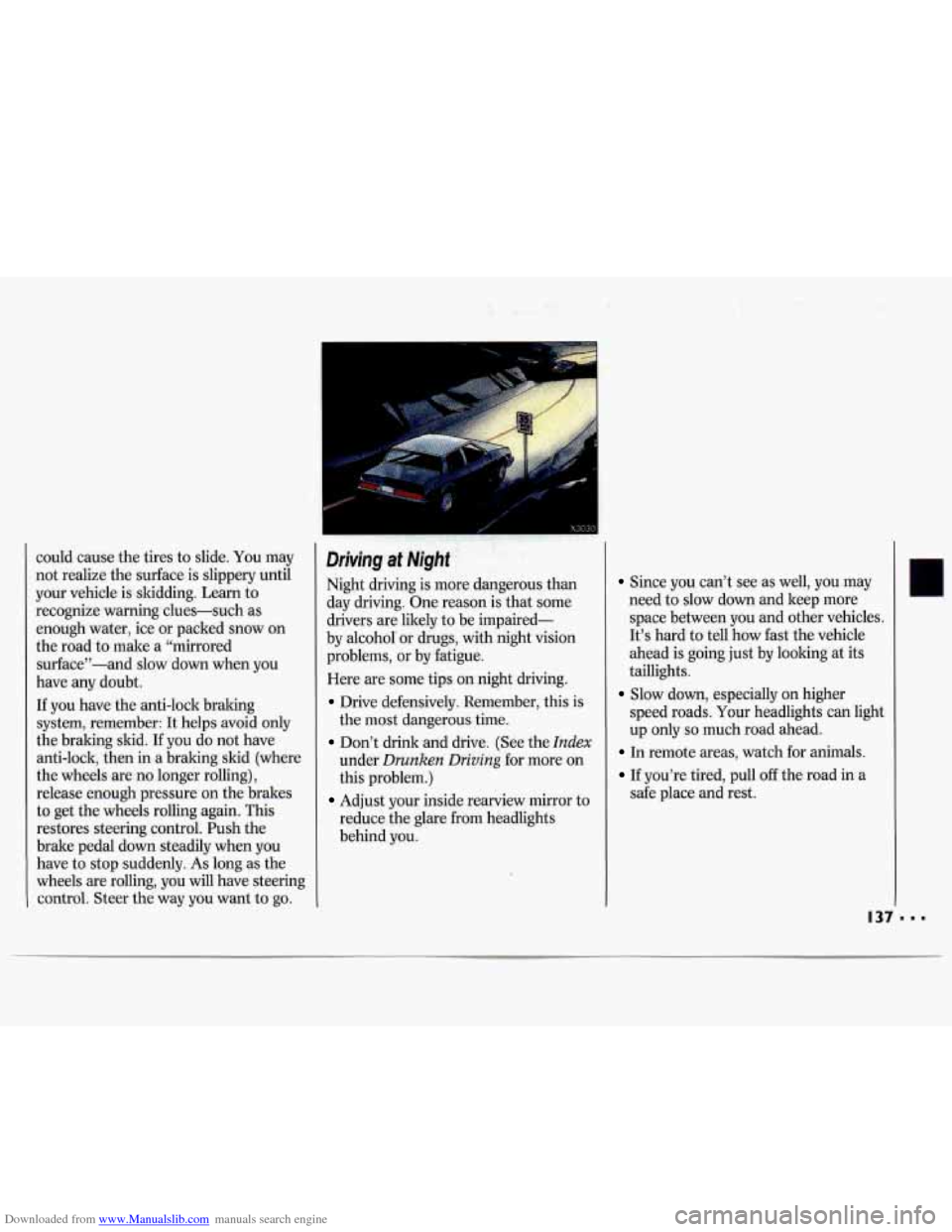
Downloaded from www.Manualslib.com manuals search engine -.,.. -
could cause the tires to slide. You may
not realize the surface is slippery until
your vehicle is skidding. Learn to
recognize warning clues-such as
enough water, ice or packed snow on
the road to make a “mirrored
surface”-and slow down when you
have any doubt.
If you have the anti-lock braking
system, remember: It helps avoid only
the braking
skid. If you do not have
anti-lock, then
in a braking skid (where
the wheels are no longer rohg),
release enough pressure on the brakes
to get the wheels rolling again.
This
restores steering control. Push the
brake pedal down steadily when
you
have to stop suddenly. As long as the
wheels are rolling, you will have steering
control. Steer the way you want to
go.
-
X3030 , , -;. - ., ,
Driving. at Might
Night driving is more dangerous than
day driving. One reason is that some
drivers are likely to be impaired-
by alcohol or drugs, with night vision
problems,
or by fatigue.
Here are some tips on night driving.
Drive defensively. Remember, this is
the most dangerous time.
Don’t drink and drive. (See the Index
under Drunken Driving for more on
this problem.)
Adjust your inside rearview mirror to
reduce the glare from headlights
behind you.
Since you can’t see as well, you may
need to slow
down and keep more
space between you
and other vehicles.
It’s hard to tell how fast the vehicle
ahead’is going just by looking at its
taillights.
Slow down, esp.ecially on higher
speed roads. Your headlights can light
up only so much road ahead.
In remote areas, watch for animals.
If you’re tired, pull off the road in a
safe place and rest.